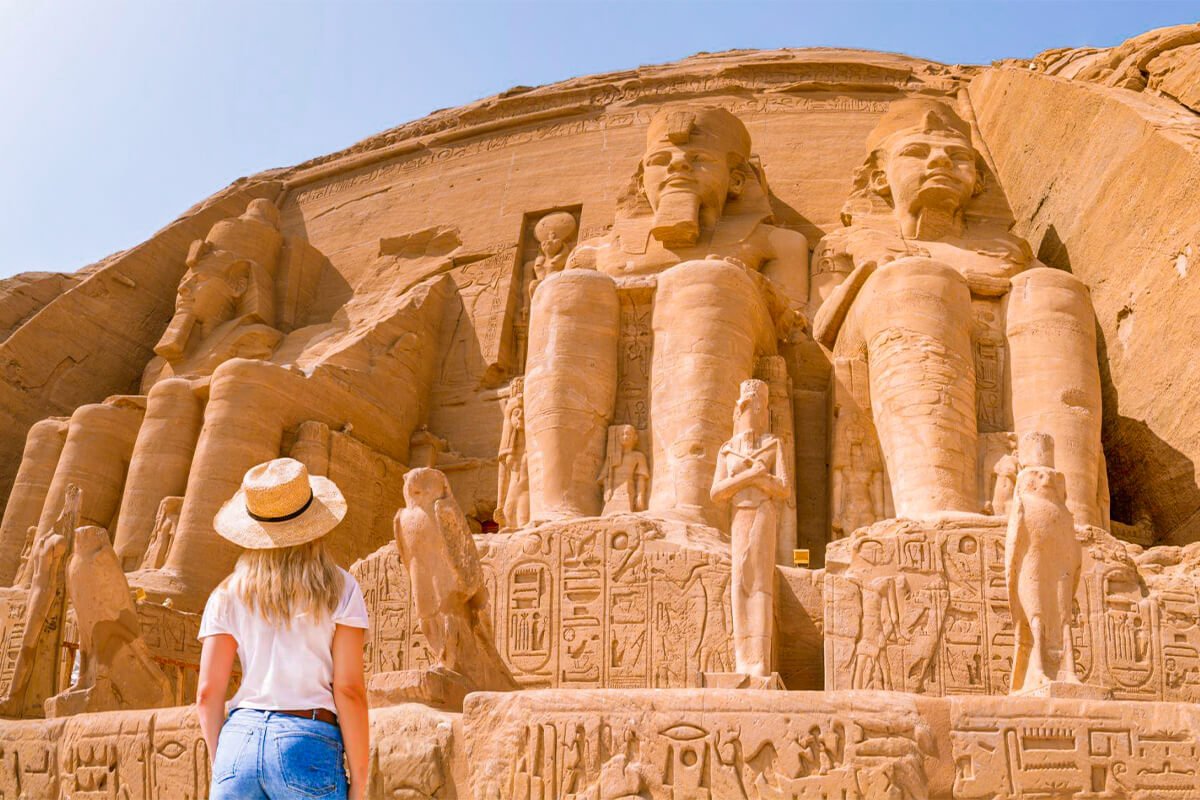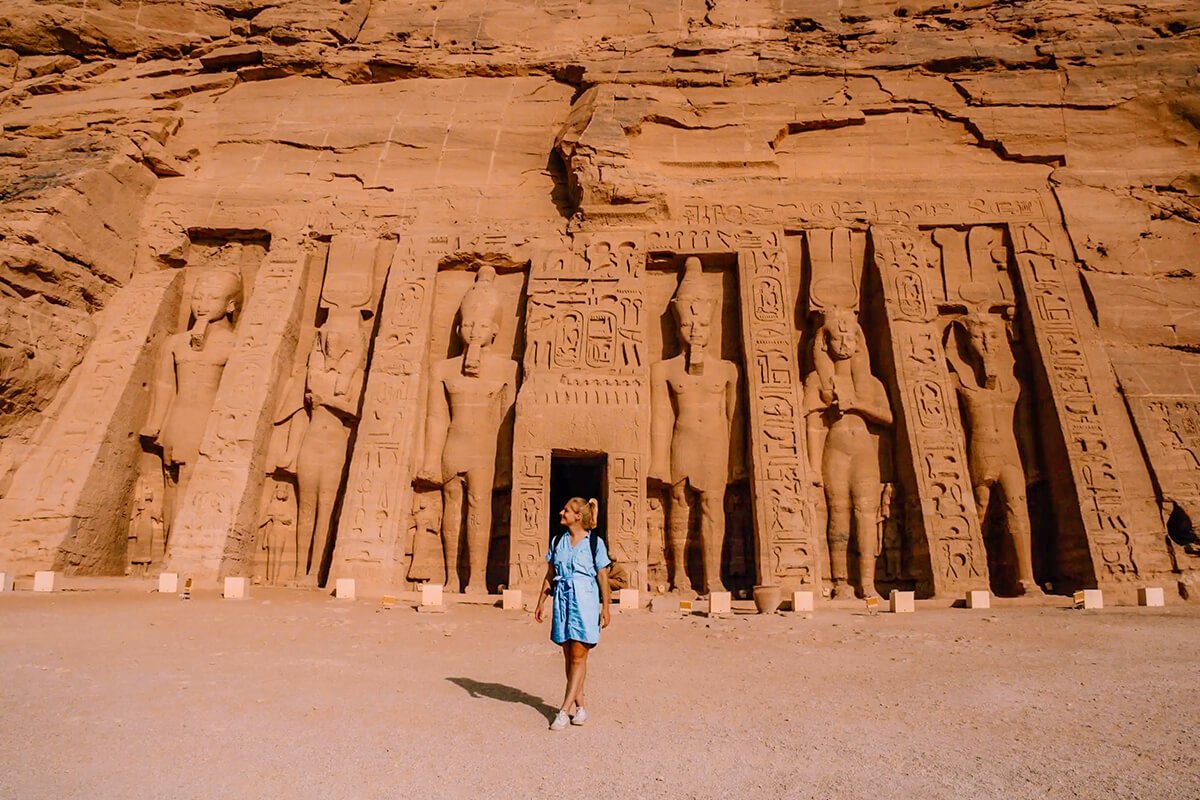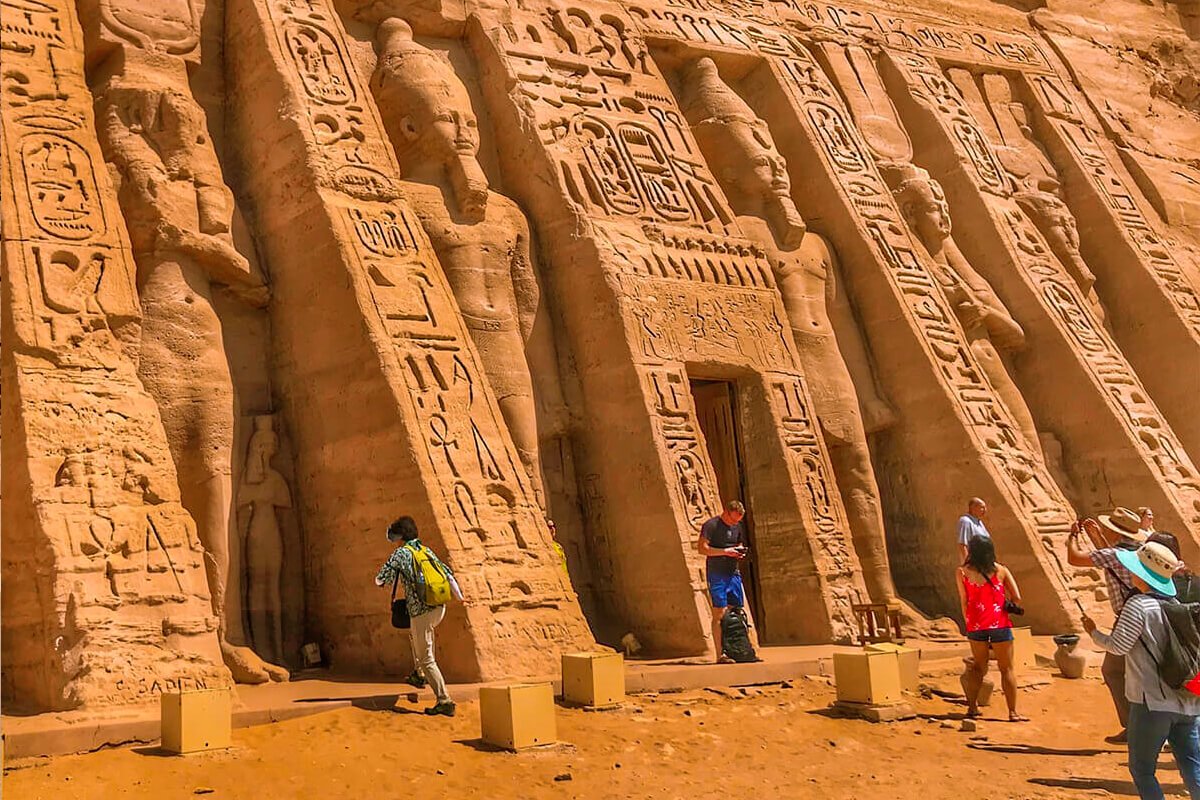Abu Simbel Temple: Exploring the Marvels of Ancient Egypt
Welcome to Abu Simbel Temple, an ancient Egyptian marvel that captivates travelers and history buffs. This magnificent temple complex along the Nile River shows the pharaohs’ grandeur and their skilled artisans’ engineering feats.
We’ll explore the temple’s history, significance, architectural marvels, and impressive relocation project that saved it from rising waters as we travel through time. Prepare to experience Abu Simbel Temple’s beauty and stone stories.
Discover Egypt’s ancient wonders! Book your Egypt Vacation Packages now!
The History and Significance of Abu Simbel Temple
Explore the history of the temple’s construction.
Nestled along the banks of the Nile River, Abu Simbel Temple boasts a remarkable history that dates back over 3,000 years. This architectural marvel was built during the reign of Pharaoh Ramses II, one of ancient Egypt’s most influential rulers, around 1264 BCE.
Its construction was no small feat – it involved carving colossal statues and intricate reliefs into the sandstone cliffs, showcasing the extraordinary craftsmanship of that era.
The purpose behind the temple’s creation was to immortalize the pharaoh’s power and legacy while celebrating the gods. It served as a grand monument to himself and a place of worship, reflecting the ancient Egyptian belief in the divine nature of their rulers.
Explain the cultural and historical significance of Abu Simbel Temple.
Abu Simbel Temple holds profound cultural and historical importance, offering a captivating window into the past. The temple complex represents not just the grandeur of the New Kingdom’s architecture but also the enduring legacy of Ramses II, who sought to establish his rule as a divine and powerful leader.
The colossal statues of Ramses II, measuring 20 meters in height, symbolize his might and leadership, immortalizing him in stone. Beyond its historical relevance, Abu Simbel also has deep religious significance.
The temple’s alignment and structure were designed to honor the gods Ra-Horakhty, Ptah, and Amun, embodying the religious beliefs of ancient Egyptians. It served as a place of worship and offerings to the gods, cementing the spiritual connection of the people to their rulers and deities.
Highlight UNESCO’s recognition and protection of the site
In recognition of its cultural importance and architectural brilliance, Abu Simbel Temple earned a spot on the UNESCO World Heritage List in 1979. UNESCO’s designation underscores the global significance of this site and its need for protection.
The temples’ recognition and subsequent protection by UNESCO was a remarkable achievement in preserving our shared heritage. It was, in fact, due to the imminent threat of submersion caused by the construction of the Aswan High Dam on the Nile River that the temples were painstakingly relocated to their current position, ensuring their continued preservation for future generations.
The efforts to safeguard Abu Simbel Temple are a testament to the world’s commitment to preserving these historical treasures, allowing travelers to witness its grandeur and learn about ancient Egypt’s rich history and culture.

Don’t miss checking out our article:
- Explore Egypt Travel Tips to make the most of your trip.
- Uncover the Landmarks in Egypt and step into history.
Location and Accessibility
Describe the geographical location of Abu Simbel Temple in Egypt.
Situated in the southern reaches of Egypt, Abu Simbel Temple is perched on the western bank of Lake Nasser, near the border with Sudan.
Its specific location in the Nubian desert, surrounded by a landscape of arid beauty and towering dunes, offers a striking contrast to the lush Nile Valley further north.
The temple’s remote setting adds to its allure, making it an intriguing destination for those seeking an off-the-beaten-path adventure in Egypt.
Provide information on how travelers can reach Abu Simbel.
Getting to Abu Simbel Temple may involve some travel, but the journey is undoubtedly part of the adventure. The primary gateway to Abu Simbel is Aswan, a city in southern Egypt, with an airport with regular flights from Cairo and other major Egyptian cities.
Once you arrive in Aswan, you can reach Abu Simbel. The most common means of transportation is a domestic flight from Aswan International Airport to Abu Simbel Airport. This short flight offers breathtaking views of the Nile and the surrounding desert.
Due to its remote location close to the Sudanese border, there is another way to get to Abu Simbel: a convoy of tourist buses escorted by security personnel. Bus travel allows you to soak in the desert landscape during the approximately 3-4 hour journey. Still, it’s important to note that the convoy schedule may vary, so it’s advisable to check in advance.
Mention the best time to visit.
The best time to visit Abu Simbel Temple and fully appreciate its grandeur is October to April. These are the cooler winter months in Egypt, and the temperature is more comfortable for exploring the temple complex.
The moderate climate ensures that you can explore the outdoor site without the scorching heat that the summer months bring. The highlight of visiting Abu Simbel during this period is the Sun Festival, which occurs twice a year. On February 22nd and October 22nd, the rising sun aligns perfectly to illuminate the inner sanctum, casting light on the statues of the gods and Pharaoh Ramses II.
This event adds an extra layer of magic to your visit. However, if you prefer fewer crowds, plan your stay during the shoulder seasons of late October to early November or late February to early March, when the weather is pleasant and tourist numbers are lower.
Join us for adventure and discovery on our Egypt Day Tours.
Architectural Marvel of Abu Simbel Temple

Describe the grandeur and scale of the temple.
Abu Simbel Temple is a monumental testament to the ingenuity and ambition of ancient Egyptian architects and artisans. The sheer grandeur of this temple complex is awe-inspiring. As you approach, you’ll be met with colossal statues, around 20 meters in height, guarding the entrance.
These towering figures represent Pharaoh Ramses II, seated in a commanding pose, symbolizing his dominance and strength. The sense of scale becomes even more apparent as you venture further into the temple, with vast halls, chambers, and intricately carved pillars that seem to stretch to the heavens.
The immensity of Abu Simbel Temple evokes a sense of humility as you stand in the presence of an architectural masterpiece that has withstood the test of time.
Explore the detailed architecture and design.
You’ll be astounded by the builders’ accuracy and attention to detail as you look deeper into the temple’s architecture and design. The walls and pillars are adorned with remarkable bas-reliefs depicting scenes from the life of Ramses II, his military victories, and religious rituals. Hieroglyphics covering the surfaces narrate the pharaoh’s accomplishments and connections to the gods.
The meticulous artistry serves as a valuable record of ancient Egyptian culture and society, offering a glimpse into the daily lives and beliefs of the time. The symmetry and balance in the design, combined with the use of natural light, create a harmonious and spiritual atmosphere within the temple.
Discuss the temple’s alignment and its solar phenomena.
One of the most captivating aspects of Abu Simbel Temple’s architecture is its alignment with the sun’s path. Twice a year, during the Sun Festival on February 22nd and October 22nd, the rising sun bathes the inner sanctum in its golden glow. This alignment is no coincidence; ancient Egyptian astronomers and architects meticulously calculated it.
The temple’s design allows sunlight to penetrate the sanctuary, illuminating the statues of the gods and Pharaoh Ramses II at the temple’s rear. The remarkable precision of this alignment testifies to the advanced knowledge and astronomical expertise of the ancient Egyptians. Visitors are left in awe as they witness this celestial event, which symbolizes the divine connection between the pharaoh and the gods and adds a layer of mystique to the temple’s already breathtaking architecture.
The Great Temple of Ramses II
Provide an overview of the Great Temple.
The Great Temple of Ramses II at Abu Simbel is an extraordinary testament to the ancient Egyptian pharaoh’s might and legacy. Carved into the solid rock of the Nubian desert, this temple complex is a marvel of engineering and artistry. Upon entering, visitors are greeted by the imposing facade adorned with colossal statues, setting the tone for the grandeur that lies within.
The temple itself consists of a series of halls and chambers, each meticulously designed to convey the awe-inspiring power of Ramses II. The scale and complexity of the temple are a reflection of the pharaoh’s desire to leave an indelible mark on history, not only as a leader but as a divine ruler.
Highlight the colossal statues of Ramses II.
At the heart of the Great Temple are the colossal statues of Ramses II, each standing at an astonishing 20 meters in height. These colossal depictions of the pharaoh are not just representations but powerful statements of his rule and significance. The statues are carefully carved with incredible attention to detail, portraying Ramses II in a seated position with the regal attire of a pharaoh.
Their colossal presence exudes an aura of authority, and their gaze seems to watch over the temple and all who visit. The statues are not just a visual spectacle; they also embody Ramses II’s belief in his divine status, an essential element of his reign.
Explain the purpose and religious significance of the Great Temple.
The Great Temple was constructed primarily to honor the gods of ancient Egypt and the pharaoh himself. As a place of worship, it served as a venue for the most critical religious rituals and ceremonies. The inner sanctum of the temple is adorned with statues and images of the gods Ra-Horakhty, Ptah, Amun, and Ramses II, further emphasizing the divine connection between the pharaoh and the gods.
The temple’s layout and design reflect the ancient Egyptian worldview and religious beliefs, which saw the pharaoh as a mediator between the gods and the people. Therefore, the temple held immense religious significance, reaffirming the divine authority of Ramses II while allowing the Egyptian people to connect with their deities. The Great Temple is not only an architectural masterpiece but also a spiritual nexus where history, religion, and art converge in an unforgettable experience for visitors worldwide.

The Small Temple of Hathor and Nefertari
Introduce the Small Temple
While the Great Temple of Ramses II at Abu Simbel commands much attention, the Small Temple of Hathor and Nefertari is a hidden gem that deserves its spotlight.
This smaller yet equally captivating temple sits adjacent to its grand counterpart and showcases a distinct charm and purpose. Dedicated to Queen Nefertari and the goddess Hathor, it offers a unique perspective on ancient Egyptian culture and beliefs.
Describe the unique features of the Small Temple.
The Small Temple’s uniqueness is immediately evident. Its facade features six striking statues: four of Ramses II and two of Queen Nefertari, making it one of the few temples in Egypt where a queen shares the same level of prominence as the pharaoh. This speaks to the high regard in which Queen Nefertari was held.
The interior of the Small Temple is equally captivating, with well-preserved wall reliefs showcasing Queen Nefertari engaging in various religious rituals and offering homage to the goddess Hathor. The artistry and attention to detail are remarkable, reflecting the deep reverence for the queen and the goddess.
Discuss its dedication to Queen Nefertari and the goddess Hathor.
The Small Temple is a tribute to the esteemed Queen Nefertari and the goddess Hathor, who was the patroness of music, dance, and love in ancient Egyptian mythology. Its purpose was to honor Nefertari’s divine and earthly roles.
She was not just the queen but also a beloved wife and mother, symbolizing royalty and femininity. The temple’s connection to Hathor, often depicted with cow’s horns on her head, underscores the importance of the feminine in ancient Egyptian culture. Hathor was not just a goddess but a protector of women and a source of love and joy. The Small Temple’s reliefs and inscriptions depict Nefertari offering gifts to Hathor and participating in religious ceremonies, highlighting her role as a religious figure.
The juxtaposition of these powerful female figures in the temple’s design offers a unique perspective on gender roles in ancient Egypt and the importance of women in both royal and religious contexts. This intimate and beautifully decorated temple is a testament to the enduring legacy of Nefertari and the adoration of Hathor, adding a fascinating layer to the story of Abu Simbel Temple.

FAQ about Abu Simbel Temple
How long did it take to relocate to Abu Simbel Temple?
The relocation process of Abu Simbel Temple took approximately four years to complete. It commenced in 1964 and concluded in 1968.
How was the relocation of Abu Simbel Temple accomplished?
The relocation involved cutting the temples into massive blocks weighing up to 30 tons. These blocks were then carefully transported and reassembled at a higher location, away from the encroaching waters.
What is the significance of the Abu Simbel Temple?
Abu Simbel Temple holds immense historical and cultural significance. It showcases the architectural prowess of ancient Egypt and serves as a testament to Ramses II’s reign and the gods worshiped during that era.
Can visitors enter the interiors of the temples?
Yes, visitors can explore the interiors of the Great Temple of Ramses II and the Temple of Hathor and Nefertari. However, photography may be restricted in certain areas to preserve the delicate ancient artwork.
Is Abu Simbel Temple easily accessible to tourists?
While Abu Simbel Temple is located in a relatively remote part of Egypt, it is accessible by road and air. Various tour operators and transportation services are available to facilitate visits to this awe-inspiring site.
Are there any other notable attractions near Abu Simbel Temple?
Yes, in addition to Abu Simbel Temple, visitors can explore other remarkable sites in the vicinity, such as the temples of Philae and Kom Ombo, the Nubian Museum, and the vibrant markets of Aswan.
Conclusion
Abu Simbel Temple exemplifies ancient Egypt’s grandeur and ingenuity. This impressive temple complex amazes visitors with its massive statues, intricately decorated walls, and remarkable relocation project.
Let the tales of pharaohs and gods take you back in time as you admire the grand architecture, exquisite artwork, and rich history. Abu Simbel Temple invites you into ancient Egypt’s mysteries and wonders.
So visit Abu Simbel Temple, where history is everywhere. Enjoy the majesty and timeless allure of this ancient wonder.



